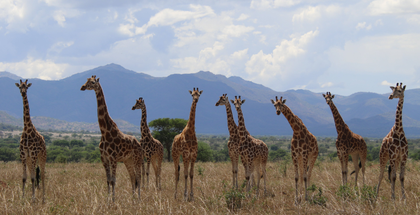Four giraffe species officially recognised in major scientific reclassification: IUCN report
By IANS | Updated: August 21, 2025 18:10 IST2025-08-21T18:03:07+5:302025-08-21T18:10:18+5:30
Windhoek (Namibia), Aug 21 A groundbreaking assessment has officially recognised four distinct giraffe species, overturning previous classifications of ...

Four giraffe species officially recognised in major scientific reclassification: IUCN report
Windhoek (Namibia), Aug 21 A groundbreaking assessment has officially recognised four distinct giraffe species, overturning previous classifications of the world's tallest land mammal as a single species.
The taxonomic review, undertaken by the International Union for Conservation of Natur (IUCN) Species Survival Commission's Giraffe and Okapi Specialist Group (GOSG) Taxonomic Task Force and made public on Thursday, marks a major milestone in the giraffe taxonomy and reshapes how giraffe diversity is understood and conserved.
Historically, giraffe (Giraffa spp.) have been classified as a single species with nine subspecies, but they have long been the subject of taxonomic uncertainty.
In response to growing scientific evidence and the urgent need for clearer conservation planning, the GOSG launched a Taxonomic Task Force in 2024 to comprehensively review the latest genetic, morphological and biogeographical data.
"This landmark taxonomic revision by the IUCN Giraffe and Okapi Specialist Group reflects the best available science and provides a globally standardised framework to inform conservation," said Michael Brown, Co-Chair of the IUCN Species Survival Commission Giraffe and Okapi Specialist Group and Conservation Science Coordinator for the Giraffe Conservation Foundation and one of the co-authors of the assessment.
"Recognising these four species is vital not only for accurate IUCN Red List assessments, targeted conservation action and coordinated management across national borders. The more precisely we understand giraffe taxonomy, the better equipped we are to assess their status and implement effective conservation strategies," Brown added.
The Task Force evaluated extensive genetic data from multiple peer-reviewed studies, many of which investigated giraffe genetics, making giraffe among the most genetically well-studied large mammal taxa in Africa.
Analyses of nuclear and mitochondrial DNA consistently revealed large differences between several giraffe lineages, supporting the recognition of multiple species.
Complementing the genetic work, the review also incorporated studies of morphological differentiation, including notable differences in skull structure and bone shape across regions.
Biogeographic assessments also considered the role of natural barriers, such as major rivers, rift valleys and arid zones, that could have contributed to evolutionary isolation.
Together, these multiple lines of evidence provide scientific support for elevating certain giraffe populations to full species status, reflecting their distinct evolutionary histories.
Disclaimer: This post has been auto-published from an agency feed without any modifications to the text and has not been reviewed by an editor
Open in app